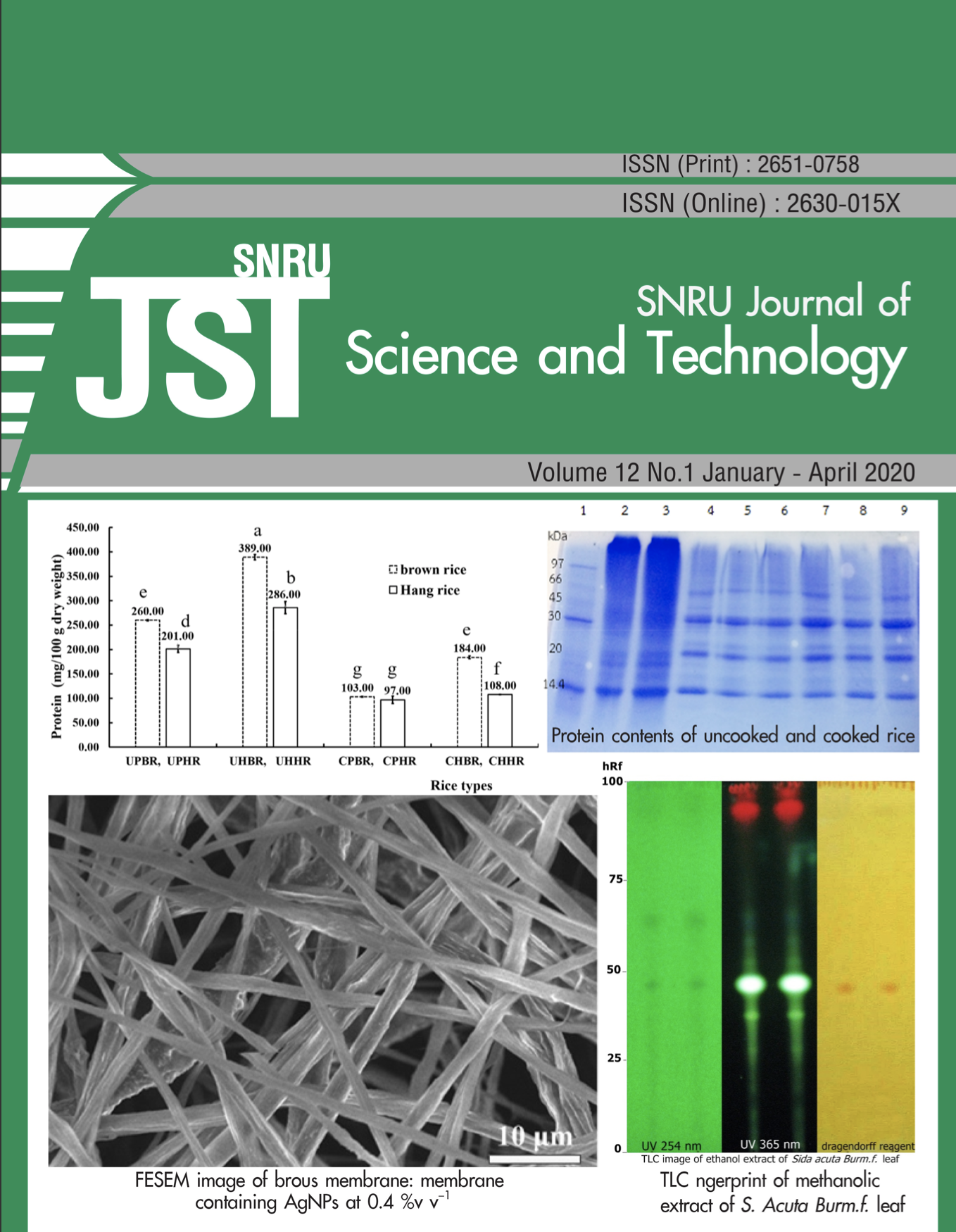Evaluation of in vitro antimalarial activity of Sida acuta Burm.f. crude extract
Keywords:
Sida acuta, antimalarial property, Plasmodium falciparum, medicinal plantAbstract
Development of resistant strains malaria parasite to many existing drugs are major concern globally. Plant derived anti-malarials remains a source of bioactive compound in this regard. The crude methanolic extracts of Sida acuta Burm.f. was tested in vitro for their antimalarial activity against Plasmodium faciparum both chloroquine sensitive and resistant strains using SYBR Green I assay. Chemical fingerprints were analyzed by thin layer chromatography (TLC) and high performance liquid chromatography (HPLC). The methanolic extract of S. acuta Burm.f. showed good antiplasmodial activity against both chloroquine resistant (K1) (IC50 25.43 – 35.69 µg mL–1) and chloroquine sensitive (3D7) (IC50 24.83 – 27.37 µg mL–1). According to the result, the crude methanolic extracts of S. acuta Burm.f. branch exhibited the lowest IC50 against P. falciparum K1 (chloroquine resistance clone)
25.43 ± 4.19 µg mL–1 and crude methanolic extracts of S. acuta Burm.f. leaves exhibited the lowest IC50 against P. falciparum 3D7 (chloroquine sensitive clone) 24.83 ± 4.81 µg mL–1. The chemical fingerprint of crude methanolic extracts of S. acuta Burm.f. using TLC fingerprint exhibited the present of alkaloid when sprayed with dragendorff’s reagent and HPLC fingerprint showed the present of quinine. In conclusion, the methanolic extract of Sida. acuta Burm.f. exhibited a good in vitro antimalarial activity against P. falciparum (IC50 < 50 µg mL–1) and can be developed as a potential antimalarial agents.
References
/s2293e.pdf, 1 August 2019.
[2] S. Esmaeili, F. Naghibi, M. Mosaddegh, S. Sahranavard, S. Ghafari, N.R. Abdullah, Screening of antiplasmodial properties among some traditionally used Iranian plants, J Ethnopharmacol. 121 (2009) 400 – 404.
[3] H. Nahrevanian, B. Esmaeili, M. Kazemi, H. Nazem, M. Amini, In vivo antimalarial effects of Iranian flora Artemisia khorassanica against Plasmodium berghei and pharmacochemistry of its natural components, Iranian J Parasitol. 5 (2010) 6 – 19.
[4] A. Ramazani, S. Sardari, S. Zakeri, B. Vaziri, In vitro antiplasmodial and phytochemical study of five Artemisia species from Iran and in vivo activity of two species, Parasitol Res. 107 (2010) 593 – 599.
[5] G.N. Zirihi, L. Mambu, F. Guede-Guina, B. Bodo, P. Grellier, In vitro antiplasmodial activity and cytotoxicity of 33 West African plants used for treatment of malaria, J Ethnopharmacol. 98 (2005) 281 – 285.
[6] L.G. Holm, D.L. Plucknett, J.V. Pancho, J.P. Herberger, The world’s worst weeds: distribution and biology, University Press of Hawaii, Honolulu, Hawaii, 1977.
[7] D.S. Jang, E.J. Park, Y.H. Kang, B.N. Su, M.E. Hawthome, J.S. Vigo, J.G. Graham, F. Cabieses, H.H. Fong, R.G. Mehta, J.M. Pezzuto, A.D. Kinghorn, Compound obtained from Sida acuta with the potential to induce quinine reductase and to inhibit 7,12-dimethylbenz[a]anthracene-induced preneoplastic lesion in a mouse mammary organ culture model, Arch Pharm Res. 26 (2003) 585 – 590.
[8] T.N. Bennett, M. Paguio, B. Gligorijevic, C. Seudieu, A.D. Kosar, E. Davidson, P.D. Roepe, P.D. Novel, Rapid and inexpensive cell-based quantification of antimalarial drug efficacy, Antimicrob Agents Chemother. 48 (2004) 1807 – 1810.
[9] W. Trager, J.B. Jensen, Human malaria parasites in continuous culture, Science. 193 (1976) 673 – 675.
[10] M.L. Willcox, G. Bodeker, P. Rasoanaivo, Traditional medicinal plants and malaria, CRC Press, Boca Raton, 2004.
[11] D. Karou, M.H. Dicko, S. Sanon, J. Simpore, A.S. Traore, Antimalarial activity of Sida acuta Burm f. (Malvaceae) and Pterocarpus erinaceus Poir. (Fabaceae), J Ethnopharmacol. 89 (2003) 291 – 294.
[12] S.D. Karou, W.M.C. Nadembega, D.P. Ilboudo, D. Ouermi, M. Gbeassor, C.D. Souza, J. Simpore, Sida acuta Burm.: a medicinal plant with numerous potencies, Afr J Biotechnol. 6(25) (2007)
2953 – 2959.
[13] M.A. Ekpo, P.C. Etim, Antimicrobial activity of ethanolic and aqueous extracts of Sida acuta on microorganisms from skin infections, J Med Plants Res. 3(9) (2009) 621 – 624.
[14] A. Mann, M. Gbate, A.N. Umar, Sida acuta subspecies acuta. Medicinal and economic plant of Nupeland, Jube Evanns Books and Publication, 2003.
[15] J.T. Banzouzi, R. Prado, H. Menan, A. Valentin, C. Roumestan, M. Mallie, Y. Pelissier, Y. Blache, Studies on medicinal plants of Ivory Coast: investigation of Sida acuta for in vitro antiplasmodial activities and identification of an active constituent, Phytomed. 11 (2004) 338 – 341.
[16] S. Katib, N. Ruangrungsi, W. Chaijaroenkul, K. Rungsihirunrat, Standardization parameters, Internal Transcribed Spacer nucleotide sequence and their anti-malarial activity of Eurycoma longifolia Jack, Int J Adv Pharm Biol Chem. 4(1) (2015) 1 – 6.
[17] C.W. Wright, Antiprotozoal Natural Products, In: E.C. Evans, Trease and Evans Pharmacognosy, 16th ed, Edinburgh, Saunders, 2009, pp. 428 – 434.









